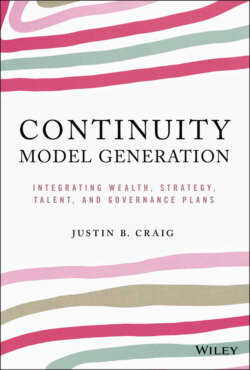Читать книгу Continuity Model Generation - Justin B. Craig - Страница 21
RIPCC Best Practice Dimensions
ОглавлениеThe RIPCC framework is something I have stolen, but paraphrased, from a book written by my friend and colleague Professor Emeritus John Ward. But given the remarkable number of books and articles John has produced to help readers understand family enterprises, it's difficult for me even to know from which work I got the idea!
Ward didn't call it the RIPCC framework, but as I recall, this is what he referred to when answering a question someone posed about what he believes families who get it right actually do, based on his decades of work with business families. I've paraphrased the lessons that these families have taught him into these five dimensions.
The first dimension, the one that begins with R, is that the families respect the challenge: that is, families who get it right understand that functioning optimally in a business-owning family is challenging. The second dimension, the I, reflects that Ward believes the issues across families are the same, but the perspectives are different. What that means, I suggest, is that the issues facing business-owning families are fundamentally the same, but how they manage and navigate these issues will vary, dependent on the perspectives of individuals and family groups. The third dimension relates to planning. Ward suggests that those who get it right don't leave it to chance. They are consummate planners. This dimension, though not intentionally framed as such, is at the epicenter of the Continuity Canvas and will be clear in Part II.
The fourth dimension of the RIPCC framework concerns communication. Ward suggests families who get it right are those who find ways to communicate. Finally, and arguably the most important of the RIPCC best practice framework dimensions, concerns having a commitment: to the “us” in question.
Taking those dimensions and contextualizing them for the Continuity Model Generation, it is simple to argue that continuity will be significantly enhanced if stakeholders understand five things: (i) respect that it will be challenging; (ii) understand that the issues may be the same across families but people will have different perspectives; (iii) recognize the importance of developing plans for ownership, family, and the many entities that are being managed; (iv) see communication as vital; and (v) believe that continuity won't occur without a commitment, a significant commitment, to what the family is trying to achieve. That's the RIPCC in action (Illustration 9).
Illustration 9 RIPCC FRAMEWORK
